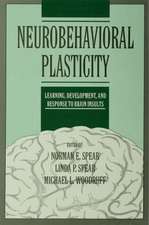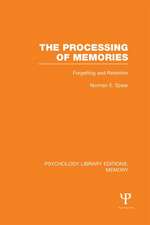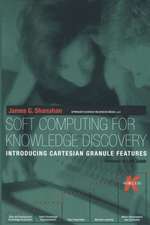The Expression of Knowledge: Neurobehavioral Transformations of Information into Action
Autor Robert L. Isaacson, Norman E. Spearen Limba Engleză Paperback – 11 dec 2012
Preț: 338.68 lei
Preț vechi: 423.35 lei
-20% Nou
Puncte Express: 508
Preț estimativ în valută:
64.80€ • 67.84$ • 53.62£
64.80€ • 67.84$ • 53.62£
Carte tipărită la comandă
Livrare economică 05-19 aprilie
Preluare comenzi: 021 569.72.76
Specificații
ISBN-13: 9781468478921
ISBN-10: 1468478923
Pagini: 444
Ilustrații: 442 p. 55 illus.
Dimensiuni: 152 x 229 x 23 mm
Greutate: 0.59 kg
Ediția:1982
Editura: Springer Us
Colecția Springer
Locul publicării:New York, NY, United States
ISBN-10: 1468478923
Pagini: 444
Ilustrații: 442 p. 55 illus.
Dimensiuni: 152 x 229 x 23 mm
Greutate: 0.59 kg
Ediția:1982
Editura: Springer Us
Colecția Springer
Locul publicării:New York, NY, United States
Public țintă
ResearchCuprins
1 The Problem of Expression.- 1. Introduction.- 2. Knowledge.- 3. Assessing Knowledge.- 4. What Determines Expression?.- 5. Examples of the Problem.- 6. Retrieval of Memories.- 7. References.- 2 Memory, Amnesia, and the Episodic/Semantic Distinction.- 1. Introduction.- 2. Episodic and Semantic Memory.- 3. Organic Amnesia.- 4. Hypnotic Amnesia.- 5. Functional Retrograde Amnesia.- 6. Concluding Comments.- 7. References.- 3 A Conditioning Analysis of Infant Memory: How Do We Know They Know What We Know They Knew?.- 1. Introduction.- 2. The Inference of Memory Processing and Retention.- 3. A Conditioning Analysis of Infant Memory.- 4. Forgotten But Not Gone: The Reactivation of Infant Memory.- 5. Summary and Conclusions.- 6. References.- 4 Memory Retrieval Failures Produced by Changes in Drug State.- 1. Introduction.- 2. Common Drug Effects on Learning and Retention.- 3. A Conceptual History of State-Dependent Retrieval.- 4. Recent Evidence about the Mechanism of SDR and DDS.- 5. References.- 5 Neuropeptides and Memory.- 1. Introduction.- 2. Pro-opio-melanocortin fragments, Memory, and Cognition.- 3. Hypothalamic Neurosecretory Peptides in Memory and Cognition.- 4. Are Neuropeptides Indispensable for Memory and Cognition?.- 5. Conclusion.- 6. References.- 6 Memory, Remembering, and Amnesia.- 1. Introduction.- 2. On Ribot’s and Robbins’s Principles.- 3. On the Theory of Long-Term Decay.- 4. On the Theory of Memorial Displacement.- 5. On the Theory of Trace Amalgamation.- 6. On the Theory of Distributed Storage.- 7. On Storage of Completely Latent Memories.- 8. On the Functions of the Prefrontal Cortex.- 9. On the Functions of the Temporal Neocortex.- 10. Conclusion.- 11. References.- 7 The Hippocampus and the Expression of Knowledge.- 1. Introduction: Summational andRetrieval Processes.- 2. The Hippocampus and Memory.- 3. Hippocampal Ablation in Animals: An Overview.- 4. Conditional Operations.- 5. Retrieval during Acquisition.- 6. Dimensions.- 7. Transformations.- 8. Relations between Conditional and Summational Systems.- 9. Summary.- 10. References.- 8 Motivation, Activation, and Behavioral Integration.- 1. Introduction.- 2. Behavioral Fragmentation and Reintegration Following Lateral Hypothalamic Damage.- 3. Sensory Neglect: An Activational Deficit.- 4. Recovery of Motivated Behavior.- 5. Hypothalamic Activation of Patterned Reflexes.- 6. The Role of Activation in Development.- 7. Activation and Changing Concepts of the Reticular Formation.- 8. Conclusions.- 9. References.- 9 Neurochemical Consequences of Stress: Intrusion of Nonassociative Factors in Behavioral Analysis.- 1. Introduction.- 2. Stress and Avoidance Behavior.- 3. Escape Behavior.- 4. Stress and Neurochemical Change.- 5. Pharmacological Manipulations and Avoidance Performance.- 6. Pharmacological Manipulations and Escape Behavior.- 7. Analgesia.- 8. Summary.- 9. References.- 10 Lateralization of Emotional or Behavioral Responses in Intact and Hemisphere-Damaged Humans and Rats.- 1. Introduction.- 2. Noncortical Areas Involved in Human Emotion.- 3. Human Hemispheric Specialization in Normals.- 4. Human Clinicopathological Correlations.- 5. Animal Studies and Lateralization.- 6. Conclusions.- 7. References.- 11 Neural and Mental Capacities.- 1. Introduction.- 2. Habits.- 3. Automatic and Voluntary Acts.- 4. Motor Systems and Mental Activity.- 5. Brain Damage and Performance.- 6. Frustration-Induced Perseveration.- 7. A Mental Currency.- 8. Brain Damage and Mental Capacities.- 9. Reprise.- 10. References.

















